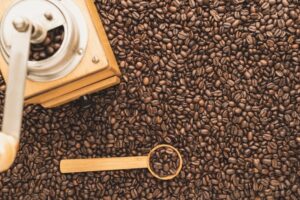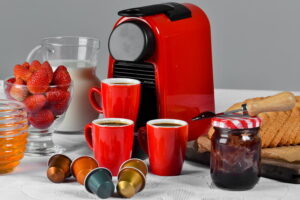Is cold brew stronger than espresso? There is a lot of debate surrounding this topic. Some people swear by cold brew’s smooth, rich flavor, believing it’s less strong than espresso. At the same time, others find espresso’s punchy flavor stronger than cold brew.
Contents
Is Cold Brew Stronger Than Espresso?
Yes, cold brew is stronger than espresso because it has a higher caffeine content since it is brewed for a longer time, using chilled water. The cold brewing process also uses more coffee beans, almost double or triple the amount used in making espresso.
Cold-brewed coffees retain more of the flavor profile from where it’s grown than traditional hot beverages like espresso. Its preparation method doesn’t involve heating or boiling – which kills off some essential oils in your beans. This ensures that you’re getting only pure caffeine without anything else mixed into each cup.

Why Is Cold Brew Stronger Than Espresso?
The ratio of coffee grounds to water is important because it determines the strength of the drink. A higher ratio means a stronger drink.
This ratio is typically around 63 grams of coffee per ounce of water for espresso. This is done on purpose to create a flavorful cup of coffee. The average coffee grounds to water ratio is much higher for cold brew, about 200 grams of coffee per liter of water, making it stronger than espresso.
Here are other factors that make cold brew stronger than espresso.
Brewing Duration
Espresso is typically brewed for about 25 seconds, while cold brew takes 12-24 hours. The longer the coffee is brewed, the more caffeine is extracted. This means that cold brew has more caffeine than espresso, making it stronger.
Extraction Yield
The yield is the percentage of coffee that is dissolved into water. Higher yield gets more extraction and less strength. Espresso has a high extraction yield of about 18%, while cold brew has an extraction yield of about 12-13%.
This is due to the time difference in brewing as well as the use of hot water in espresso. Cold brew has a relatively lower extraction yield, making it stronger than espresso.
Total Dissolved Solids (TDS)
Another significant difference between cold brew and espresso is the TDS. TDS is the measure of all the dissolved solids in a liquid and is expressed in parts per million (ppm).
The higher the TDS, the more bitter the coffee will taste. Espresso has a TDS of about 50-70 ppm, while cold brew has a TDS of about 80-110 ppm. This is due to the use of cold water in making cold brew which extracts more compounds from the coffee beans.
Ingredients
Espresso is made with finely ground coffee beans, while cold brew uses coarsely ground coffee beans. This difference in grinding affects the flavor and strength of the two drinks.
The finer grind of espresso creates a more intense flavor, while the coarser grind of cold brew results in a less bitter drink. If the grind is too coarse and the contact time with water is less, the resulting drink will turn out weak.
However, this is not the case with cold brew since coffee grounds are steeped in water for extended periods making it stronger than espresso.

Coffee Bean Type
The type of coffee bean also affects the strength and flavor of the drink. Espresso is made with dark roast beans, while the cold brew is commonly made with light roast beans.
Dark roast beans are roasted for a longer time, which gives them a burnt flavor and makes the coffee beans lose more water content. Since light roasts are generally roasted for a shorter time, the coffee is denser and retains more minerals and caffeine, making cold brew stronger.
How Does Cold Brew Compare to an Espresso?
Cold brew is made with less heat, so it doesn’t come out tasting burnt, which is the flavor most people associate with coffee. The acidity level tends to be lower which means there aren’t enough citrus flavors popping in your mouth when you drink cold brew versus drinking a shot of espresso.
Here are other ways cold brew compares to espresso:
Caffeine Content
A traditional shot of espresso is about one ounce and has an average caffeine content of around 75 milligrams, in which its effects can last for at least 2 hours before it wears off. Cold brew typically contains more caffeine since the grounds are steeped in water for a longer time.
It is important to note that the caffeine content of cold brew is high per serving, while that of the espresso is higher per shot or per ounce.
Flavor
The brewing process also affects the flavor of the coffee. Espresso is brewed using pressure, which extracts fewer flavor compounds. As a result, cold brew tends to have a smoother, less bitter flavor than espresso.
The long brewing process of cold brew allows more time for the coffee to extract flavors and aromas. Cold brew also has a higher concentration of coffee oils. This results in a more complex flavor profile than espresso making it stronger.
Health Benefits
There are also some health benefits to consider when comparing espresso and cold brew. Espresso is high in antioxidants, which can help protect the body against free radicals.
It is also a rich source of magnesium, potassium, and calcium. Cold brew is lower in antioxidants than espresso, and it is a good source of vitamins B2 and B5.
Consistency
The consistency of cold brew can vary depending on how it is brewed. If you make cold brew at home, you can control the consistency by adjusting the ratio of coffee to water. Generally speaking, cold brew is a bit more diluted than espresso.
On the other hand, espresso is consistently brewed with a specific ratio of coffee to water. It is thick, concentrated, and creamy. As a result, espresso has a more consistent consistency than cold brew.y

Daily Intake
You can have more shots of espresso in a day than cups of cold brew. A standard cup of coffee contains about 95 mg of caffeine, while a standard shot of espresso has about 63 mg.
This means you can have a double or triple shot of espresso in a day. The servings of cold brew are much larger, making it difficult to consume several cups.
Keep in mind that this is just a general guideline. If you’re sensitive to caffeine, you may want to stick to one cup of cold brew or one shot of espresso. Taking both an espresso and cold brew on the same day can also lead to caffeine overload. Make sure to stick to the recommended daily intake to avoid coffee toxicity that could lead to death.
Acidity
Cold brew has low acid levels because it is brewed using cold water, which prevents the coffee from releasing acidic compounds during the brewing process.
Espresso is low in acidity because it is made using dark roasts. Dark roasts are roasted for a longer time, thus losing the chlorogenic acids.
Is Decaf Cold Brew Stronger Than Espresso?
Decaf cold brew will generally be less strong than espresso. A decaf cold brew is made with decaffeinated coffee beans, with less caffeine than regular coffee beans. The brewing process for decaf cold brew is the same as regular cold brew; however, the beans are pre-treated to remove the caffeine.
As a result, the final drink will have less caffeine than espresso made with regular coffee beans. Espresso made with decaf coffee beans will taste different but it will also be less strong than espresso made with regular coffee beans. However, the difference in strength will be less noticeable than with cold brew.
This is because espresso is already a concentrated coffee drink, so removing some caffeine will not make as big a difference as a cold brew. Overall, decaf cold brew is a good choice if you’re looking for a caffeine-free option.
Is Nitro Cold Brew Stronger Than Espresso?
Nitro cold brew is a type of cold brew infused with nitrogen gas. Nitrogen gas is used to give the coffee a creamy, frothy texture. Nitro cold brew has a higher concentration of caffeine than regular cold brew. As a result, nitro cold brew is much stronger than espresso.
A nitro cold brew caffeine content is in the ratio of about 200-300mg/16oz. Espresso caffeine content is in the ratio of about 80-100 mg/shot.
If you’re looking for a strong coffee drink, nitro cold brew is a good choice. However, keep in mind that it can be quite bitter. If you’re sensitive to bitterness, you may want to stick with regular cold brew or espresso.
Is Cold Brew Stronger Than Regular Coffee?
No, cold brew is not stronger than regular coffee. The difference in caffeine content is because cold brew is brewed at a lower temperature and for a longer time. This allows for a more gradual extraction of caffeine from the beans. However, nobody drinks cold brew concentrate straight.
You add water, ice, or even milk to make a cold brew. This reduces the caffeine content making it similar to that of a regular cup of coffee.
Related Questions
Which Coffee Beans Are Best for Cold Brew?
The best beans for cold brew are Arabica. These have a sweeter, smoother taste than Robusta coffee – which is why they’re typically used in iced beverages like lattes and macchiatos instead.
Is Cold Brew the Strongest Coffee?
Cold brew concentrate is a stronger drink with a higher coffee grounds to water ratio making its caffeine content very high than regular drip coffee. However, cold brew concentrate is added to water, milk, or ice before consumption, diluting its caffeine concentration.
Conclusion
So, is cold brew stronger than espresso? Yes, due to the higher caffeine content and extraction yield. Cold brew also has a higher TDS, making it even stronger than espresso. However, other factors such as the brewing time and ratio of coffee grounds to water contribute to the difference in strength.



